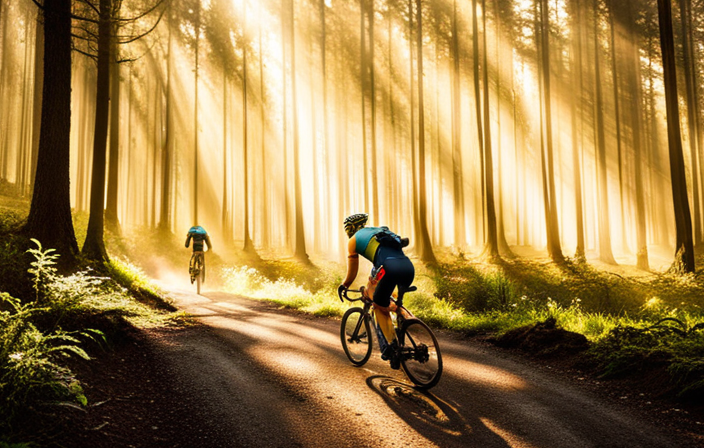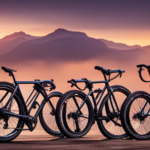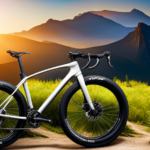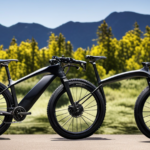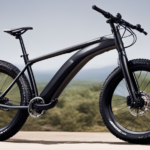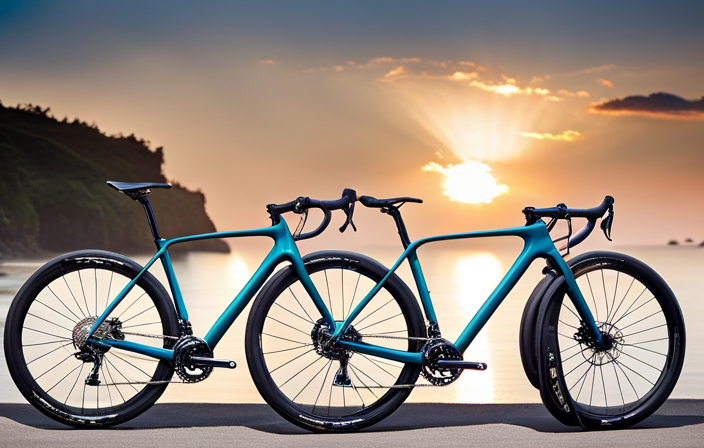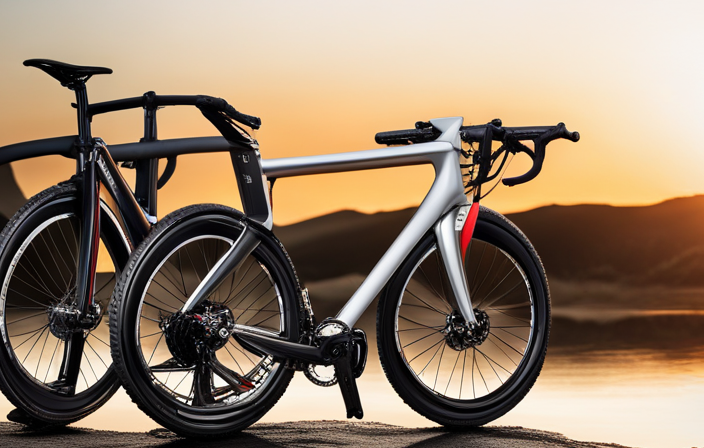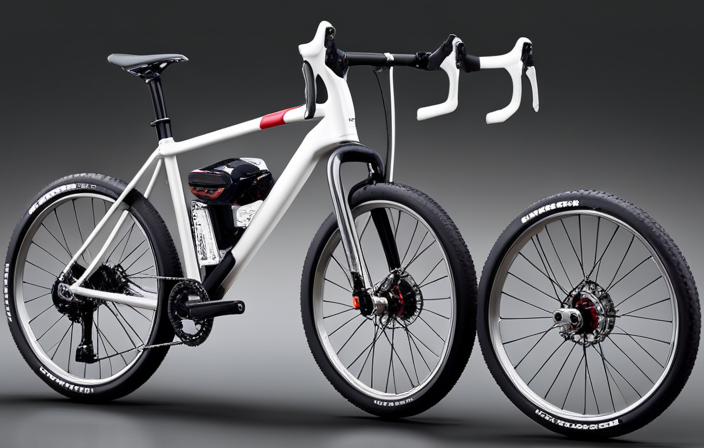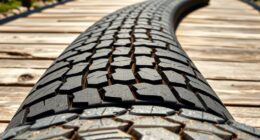Gravel bikes blend the excitement of traversing off-road trails with the fast pace of road cycling, providing a multifaceted option for adventurers on bicycles. These bikes are engineered with sturdy frames, broader tires, and a design aimed at long-lasting performance, allowing them to excel on both smooth roads and challenging off-road paths.
But what exactly is a gravel bike used for? In this article, we will delve into the origins, key features, and various applications of these all-terrain wonders.
So buckle up and join me as we uncover the world of gravel biking.
Key Takeaways
- Gravel bikes are designed for various terrains, offering stability and traction with wide tires and tread patterns.
- They are versatile and durable, allowing for off-road exploration in rugged terrains that are inaccessible to road bikes.
- Gravel biking can be used for long-distance rides, multi-day adventures, gravel races, urban commuting, and exploring remote areas.
- Proper gear selection, maintenance, and safety precautions are essential for a smooth and safe gravel biking experience.
The Origins of Gravel Bikes
If you’re wondering about the origins of gravel bikes, they can be traced back to the early 2000s. Gravel racing, a form of cycling that takes place on unpaved roads, started gaining popularity during this time. As cyclists sought out new challenges beyond traditional road and mountain biking, the need for a specialized bike arose. This led to the emergence of gravel bike manufacturers who recognized the potential market.
Gravel bikes were initially developed by modifying existing road and cyclocross frames to handle rougher terrain. The key features of a gravel bike include wider tires with tread patterns that offer more grip on loose surfaces. They also have disc brakes for improved stopping power in all conditions and clearance for mudguards or panniers to accommodate longer rides or multi-day adventures.
The versatility of gravel bikes quickly attracted riders looking for a bike that could handle everything from smooth pavement to challenging off-road sections. With their endurance-focused geometry and stable handling, these bikes are perfect for long-distance rides or exploring remote areas. In addition, many gravel races have started popping up around the world, further fueling interest in this category.
Moving on to the next section about ‘the key features of a gravel bike,’ it is important to understand how these features contribute to their performance and functionality without compromising efficiency or comfort.
The Key Features of a Gravel Bike
One of the key features of a gravel bike is its ability to handle different terrains. This is made possible by several specific components and tire selection that are unique to gravel bikes. Here are some key features that make gravel bikes stand out:
-
Wide tires: Gravel bikes typically have wider tires compared to road bikes, usually ranging from 35mm to 45mm. The increased tire width provides stability and better traction on loose surfaces like gravel or dirt roads.
-
Disc brakes: Gravel bikes are equipped with disc brakes, which offer superior stopping power and control in various weather conditions. This ensures reliable braking performance on both wet and dry surfaces.
-
Frame geometry: Gravel bike frames often feature a more relaxed geometry compared to road bikes. This allows for a more comfortable riding position over long distances while maintaining stability on rough terrain.
-
Mounts for accessories: Gravel bikes come with multiple mounts for attaching racks, fenders, and water bottle cages. These allow riders to carry extra gear during long adventures or commuting.
The combination of these features makes gravel bikes versatile machines capable of tackling various terrains with ease. Whether you’re exploring off-road trails or navigating city streets, a gravel bike provides the versatility needed for any adventure ahead.
Versatility on Various Terrains
You can easily navigate through a variety of terrains with the versatility of a gravel bike. Gravel bikes are designed to handle different surfaces, making them perfect for off-road adventures and exploring new trails. The key to their adaptability lies in their features and biking gear choices.
When riding on rough or unpaved roads, a gravel bike’s wide tires provide stability and traction, allowing you to confidently tackle uneven surfaces. These tires often have a tread pattern that grips well on loose gravel or dirt, ensuring a smooth ride even in challenging conditions. Additionally, most gravel bikes come equipped with disc brakes, which offer excellent stopping power regardless of the terrain.
To enhance your experience on various terrains, it’s essential to consider equipment choices such as tire pressure and suspension settings. Adjusting tire pressure allows you to optimize grip based on the surface conditions you encounter. Similarly, adjusting suspension settings can help absorb bumps and impacts for a more comfortable ride.
Transitioning smoothly onto pavement is another advantage of gravel bikes. Their design allows for efficient pedaling and stability at higher speeds, making them suitable for both off-road excursions and urban commuting.
In conclusion, with the right biking gear and equipment choices made specifically for varied terrains, gravel bikes provide unparalleled versatility when it comes to conquering different surfaces effortlessly.
Smooth Riding on Pavement
Smooth riding on pavement is one of the key advantages of opting for a gravel bike. With its unique design and features, a gravel bike offers an exceptional experience when it comes to pavement cruising. Whether you’re commuting to work or embarking on urban exploration, this versatile machine provides a smooth and comfortable ride.
The geometry of a gravel bike plays a crucial role in ensuring a pleasant experience on paved surfaces. The frame is designed to provide stability and control, allowing you to navigate through traffic with ease. Additionally, the wider tires absorb shocks and vibrations from uneven roads, resulting in a smoother ride compared to traditional road bikes.
Gravel bikes also come equipped with components that enhance their performance on pavement. The gearing system allows for efficient pedaling, providing optimal power transfer as you cruise along city streets. Furthermore, the disc brakes offer excellent stopping power, ensuring your safety in busy urban environments.
Transitioning into tackling gravel trails with ease, gravel bikes excel at handling various terrains effortlessly. From smooth pavements to rugged off-road paths, these bikes are built to handle it all. So let’s explore how they perform when taken off the beaten path…
Tackling Gravel Trails with Ease
When venturing onto gravel trails, tackling them with ease is made possible by the versatility and durability of a gravel bike. Gravel bikes are specifically designed to handle rough terrains, including gravel trails, making them the perfect choice for off-road adventures. To ensure a smooth ride on these trails, proper maintenance of your gravel bike is essential. Regularly checking tire pressure and tread wear will help you maintain traction and control on uneven surfaces. Additionally, cleaning and lubricating the chain will prevent rust and keep your bike running smoothly.
If you’re new to gravel biking, it’s important to familiarize yourself with the basics before hitting the trails. A beginner’s guide to gravel biking can provide valuable tips on gear selection, body positioning, and navigating different types of terrain. Learning how to shift gears effectively will also make conquering steep climbs or navigating technical descents much easier.
By taking care of your gravel bike and acquiring the necessary skills, you’ll be ready to explore off-road adventures with confidence. Whether it’s discovering hidden forest paths or embarking on multi-day journeys through rugged landscapes, a well-maintained gravel bike will be your reliable companion.
Transitioning seamlessly into the next section about exploring off-road adventures allows us to delve deeper into this exciting aspect of riding a gravel bike without skipping a beat.
Exploring Off-Road Adventures
When it comes to gravel biking, exploring off-road adventures is one of the most thrilling aspects. With a gravel bike, you can venture into rugged terrains that are inaccessible to road bikes and experience the freedom of riding through nature’s playground. Whether it’s a remote forest trail or a rocky mountain path, the versatility and durability of a gravel bike make it the perfect companion for off-road exploration.
To ensure a successful off-road adventure, there are some bikepacking tips that every gravel biker should keep in mind. Firstly, investing in high-quality gear is essential for long-distance rides. This includes durable saddlebags and frame bags to carry all your essentials. Additionally, selecting the right tires with adequate traction and puncture resistance will greatly enhance your performance on rough terrain.
When it comes to choosing the best gravel bike brands, there are several top contenders in the market. Some notable options include Specialized, Trek, Giant, Cannondale, and Santa Cruz. These brands have built their reputation on producing high-quality bikes that excel in handling diverse off-road conditions.
Now that we’ve covered exploring off-road adventures with ease using a gravel bike let’s move onto commuting in style and comfort
Commuting in Style and Comfort
To make your daily commute a breeze, you can easily ride in style and comfort with a gravel bike. These versatile bikes are not only designed for off-road adventures but also excel at urban commuting. Here are three ways to enhance your commuting experience with a gravel bike:
-
Stylish Bike Accessories: Customize your gravel bike with stylish accessories that not only add flair but also serve practical purposes. Consider adding fenders to keep yourself dry during rainy commutes or installing a rack and panniers for convenient storage of work essentials.
-
Choosing the Right Bike Size: Ensuring the proper fit is crucial for a comfortable commute. Take into account factors such as frame size, saddle height, and handlebar reach when selecting a gravel bike. A professional fitting session can help you find the perfect match for your body type and riding preferences.
-
Smooth Riding Experience: Gravel bikes come equipped with wider tires that offer increased stability and traction on various surfaces, including rough city streets. The relaxed geometry of these bikes provides a more upright riding position, reducing strain on your back and neck during long commutes.
With its stylish accessories and optimal fit, riding a gravel bike will transform your daily commute into an enjoyable experience.
Transitioning into the subsequent section about long-distance touring capabilities, let’s explore how these bikes adapt to even more adventurous journeys without compromising comfort or performance.
Long-Distance Touring Capabilities
For longer journeys, you’ll be amazed by how well these versatile and comfortable machines handle the demands of long-distance touring. Gravel bikes are ideal for bikepacking trips and can easily carry all your gear with their sturdy frames and ample mounting points. When embarking on a long-distance tour, it’s important to plan ahead and pack efficiently. Some bikepacking tips include minimizing weight, organizing gear in waterproof bags, and distributing weight evenly across the bike.
To tackle those extra miles, it’s crucial to train properly for long-distance riding. Gradually increase your mileage over time to build endurance and stamina. Incorporate interval training sessions into your routine to improve speed and power output. Additionally, focus on strength training exercises that target the muscles used while cycling.
As you transition from long-distance touring into gravel racing and endurance events, gravel bikes continue to shine. Their robust construction allows for aggressive off-road riding without compromising comfort or stability. These bikes excel in providing a smooth ride over rough terrain while maintaining efficiency on paved roads.
Next up, we’ll explore how gravel bikes perform in the competitive world of gravel racing and endurance events without sacrificing their touring capabilities.
Gravel Racing and Endurance Events
If you’re looking for a challenging and exciting racing experience, gravel racing and endurance events are where gravel bikes truly shine. These events take place on a variety of terrain, from smooth dirt roads to rocky trails, and often cover long distances. Gravel bike events offer a unique mix of speed and endurance, requiring riders to navigate technical sections while maintaining a fast pace.
To give you an idea of the different aspects of gravel racing and endurance events, here is a table breaking down some key features:
| Gravel Bike Events | Training for Gravel Racing |
|---|---|
| Varied Terrain | Endurance rides |
| Technical Sections | Interval training |
| Long Distances | Strength and core workouts |
| Fast Pace | Hill repeats |
To excel in these events, it’s important to train specifically for gravel racing. This involves incorporating endurance rides into your training routine to build up your stamina. Interval training can help improve your speed and power output on the bike. Additionally, strength and core workouts are essential for stability and control during technical sections.
Now that we’ve covered gravel racing, let’s transition into the next section about bikepacking and adventure cycling.
Bikepacking and Adventure Cycling
Get ready to embark on thrilling adventures and explore new territories with bikepacking and adventure cycling. Bikepacking is the perfect way to combine your love for biking and camping, allowing you to travel long distances off-road while carrying all your gear on your gravel bike.
As someone who has experienced the joys of bikepacking firsthand, I can offer some valuable tips to make your journey even more enjoyable.
When it comes to bikepacking, packing light is essential. Choose lightweight camping gear that won’t weigh you down, such as a compact tent, sleeping bag, and cooking equipment. Opt for durable yet lightweight panniers or frame bags that attach securely to your gravel bike, providing ample storage space.
Additionally, consider investing in a reliable GPS device or smartphone app for navigation during remote adventures. These tools will ensure you stay on track when exploring unfamiliar areas.
As for the best gear for adventure cycling, prioritize comfort and durability. A comfortable saddle will make those long rides much more enjoyable, while puncture-resistant tires are crucial for tackling rough terrains without worrying about flats.
With these essential bikepacking tips and carefully selected gear in hand, you’ll be fully prepared for unforgettable adventures on your gravel bike.
Now let’s delve into choosing the right gravel bike for you…
Choosing the Right Gravel Bike for You
Once you’ve decided to embark on your gravel adventure, it’s important to choose the right bike that suits your needs and preferences. When it comes to selecting a gravel bike, two key factors to consider are bike sizing and choosing the right components.
For bike sizing, it’s crucial to find a frame size that fits you properly. Gravel bikes come in various sizes, so take the time to try out different options and consult with experts if needed. A well-fitting bike will ensure comfort during long rides and prevent potential injuries.
When choosing components for your gravel bike, think about the type of terrain you’ll be riding on and your personal preferences. Some important components to consider include the drivetrain, brakes, tires, and handlebars. Opting for wider tires can provide more stability on rough surfaces while disc brakes offer superior stopping power in all weather conditions.
In summary, finding the right gravel bike involves considering both bike sizing and component selection. Take into account your body measurements and test different frame sizes before making a decision. Additionally, carefully evaluate each component option based on your riding style and expected terrain conditions.
As we move into discussing essential accessories for gravel biking…
Essential Accessories for Gravel Biking
One must consider essential accessories for their gravel biking experience. Gravel bike accessories can greatly enhance your riding comfort, safety, and overall enjoyment on the trails. When it comes to must-have gear for gravel biking, a few key items come to mind.
First and foremost, a good quality helmet is essential for any type of cycling. It will protect your head in case of a fall or accident. Look for a helmet that is specifically designed for off-road riding, with added coverage and ventilation.
Next, investing in a comfortable pair of cycling shorts with padding will make a world of difference during long rides. They provide cushioning and help reduce friction between you and the saddle.
Another crucial accessory is a reliable set of lights. Whether you’re riding during the day or night, having front and rear lights increases your visibility to others on the road.
Additionally, don’t forget about hydration! A hydration pack or water bottle cage mounted on your bike frame will ensure you stay properly hydrated throughout your ride.
In conclusion, these are just a few essential accessories that every gravel biker should consider investing in. Now that we have covered the necessary gear, let’s move on to maintenance and care tips to keep your gravel bike running smoothly without skipping a beat.
Maintenance and Care Tips
To ensure optimal performance and longevity of your gravel biking equipment, it’s important to follow these maintenance and care tips. Proper maintenance not only keeps your bike running smoothly but also helps prevent common issues that can arise from regular use. Here are some essential maintenance tips to keep in mind:
-
Clean your bike regularly: Use a mild detergent and water to clean the frame, drivetrain, and components. Avoid using high-pressure water as it can damage sensitive parts.
-
Lubricate moving parts: Apply lubricant to the chain, derailleurs, and other moving parts to reduce friction and ensure smooth operation.
-
Check tire pressure: Maintain the recommended tire pressure to optimize traction and prevent flats.
-
Inspect brakes: Regularly check brake pads for wear and adjust them if necessary. Ensure proper alignment for effective stopping power.
-
Monitor wear on components: Keep an eye on chainrings, cassette, and brake pads for signs of wear, as these may need replacement over time.
By following these maintenance tips, you can extend the lifespan of your gravel bike while avoiding common issues such as rusting, poor shifting performance, or worn-out brakes. These simple steps will help you enjoy a trouble-free ride on any terrain.
Now that you know how to take care of your gravel bike properly, let’s explore how you can join the vibrant gravel bike community without missing out on any excitement!
Joining the Gravel Bike Community
Ready to become part of the vibrant gravel biking community? Joining the gravel bike community is an exciting step towards embracing the freedom and adventure of this sport.
One of the first things you can do is find local gravel bike routes in your area. There are various online platforms and apps that can help you locate popular routes or connect with other riders in your region. These resources often provide detailed information about the terrain, distance, and difficulty level of each route, allowing you to choose one that suits your preferences and skill level.
When joining the gravel bike community, it’s important to engage with fellow riders both online and offline. Many cities have gravel bike clubs or groups that organize regular rides or social events. Participating in these activities not only allows you to meet like-minded individuals but also provides opportunities for learning from more experienced riders.
Additionally, engaging with online communities through forums or social media platforms can be a great way to ask questions, share experiences, and gain valuable insights from seasoned gravel bikers.
By finding local routes and connecting with other riders, you’ll quickly become immersed in the world of gravel biking. Embracing the freedom and adventure this sport offers is just a pedal stroke away!
Embracing the Freedom and Adventure of Gravel Biking
Get ready to experience the exhilarating feeling of freedom and adventure as you explore new terrains and conquer challenging obstacles on your gravel biking journey. Gravel biking opens up a world of possibilities, allowing you to ride on unpaved roads, off-road trails, and even singletrack paths. It’s about embracing the thrill of the unknown and pushing yourself to new limits.
One of the great advantages of gravel biking is the opportunity it provides for building strength and endurance on gravel trails. The uneven surfaces require constant adjustments in body position, engaging your core muscles and improving balance. As you navigate through different terrain types such as loose rocks or muddy patches, you’ll need to adapt quickly, relying on your agility and technique.
To give you an idea of what awaits you on a gravel biking adventure, picture this: imagine riding through a dense forest with sunlight streaming through the leaves overhead. On one side of the trail, vibrant wildflowers sway gently in the breeze while birds chirp melodiously in the distance. The rhythmic crunching sound beneath your tires signifies that you are conquering yet another obstacle.
Gravel biking offers an escape from busy roads into nature’s playground where every ride becomes an opportunity for exploration and personal growth. So get out there, embrace the freedom and adventure that comes with gravel biking, and let it take you on a journey unlike any other.
Frequently Asked Questions
Can a gravel bike be used for road cycling as well?
Yes, a gravel bike can be used for road cycling as well. While it is designed with off-road capabilities, it performs admirably on paved surfaces too.
The versatility of a gravel bike allows riders to enjoy both gravel and road rides without compromise. However, compared to a dedicated road bike, the slightly heavier frame and wider tires of a gravel bike may result in slightly slower speeds on long distance road rides.
Nonetheless, it still offers a comfortable and enjoyable experience for road cycling enthusiasts.
What type of tires are recommended for a gravel bike?
For a gravel bike, I recommend using tubeless tires with a wider width. Tubeless tires provide better puncture resistance and allow you to run lower tire pressures for improved traction on rough terrain.
The wider width helps provide stability and control on loose surfaces.
Remember the adage ‘a smooth sea never made a skilled sailor.’ So, equip your gravel bike with tubeless tires and the right width to tackle any adventure with confidence and skill.
Are gravel bikes suitable for mountain biking?
Gravel bikes are not suitable for mountain biking due to their design and intended use. While gravel bikes share similarities with both cyclocross bikes and hybrid bikes, they differ in key aspects.
Gravel bikes have a more relaxed geometry, wider tire clearance, and are designed for riding on mixed surfaces like gravel roads. Mountain biking requires a different frame geometry, suspension, and specific components designed for off-road trails.
What are the advantages of using a gravel bike for commuting?
The advantages of using a gravel bike for commuting are numerous. The geometry of a gravel bike differs from both road bikes and mountain bikes, making it ideal for urban riding. With slightly relaxed angles and wider tires, gravel bikes provide a comfortable and stable ride on various surfaces.
They also offer more versatility than road bikes, allowing you to explore off-road paths while still maintaining efficiency on paved roads. Additionally, the ability to mount racks and fenders makes them perfect for carrying your belongings in all weather conditions.
How does the geometry of a gravel bike differ from a road bike or a mountain bike?
Imagine you’re on a winding road, seeking adventure.
The geometry of a gravel bike sets it apart from its road and mountain counterparts. With a longer wheelbase and slacker head tube angle, it offers stability and control over rough terrains.
These differences in handling make it ideal for long distance rides, as it absorbs vibrations and bumps while maintaining speed.
Its versatility allows you to tackle any terrain, making it the ultimate companion for exploration.
Conclusion
In conclusion, gravel biking is an exciting and versatile activity that offers a unique blend of freedom and adventure. With its origins in the early days of cycling, gravel bikes have evolved to become specialized machines capable of conquering various terrains.
One interesting statistic to highlight is that according to a recent survey, the number of people participating in gravel biking has increased by 56% over the past five years. This demonstrates the growing popularity and appeal of this sport, as more riders seek out the thrill and challenge it provides.
So why not join the gravel bike community today and experience the joy of exploring new paths less traveled?

